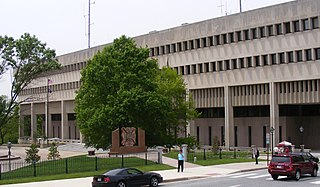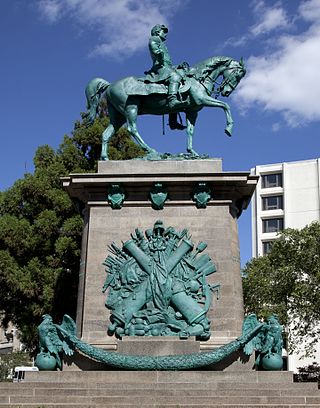
Pietro Vichi "Pete" Domenici was an American attorney and politician who served as a United States Senator from New Mexico from 1973 to 2009. A member of the Republican Party, he served six terms in the Senate, making him the longest-tenured U.S. Senator in the state's history. To date, Domenici is the last Republican to be elected to the Senate from New Mexico. He was succeeded by Democratic U.S. Representative Tom Udall.

Petroglyph National Monument stretches 17 miles (27 km) along Albuquerque, New Mexico's West Mesa, a volcanic basalt escarpment that dominates the city's western horizon. Authorized June 27, 1990, the 7,236 acres (2,928 ha) monument is cooperatively managed by the National Park Service and the City of Albuquerque. The western boundary of the monument features a chain of dormant fissure volcanoes. Beginning in the northwest corner, Butte volcano is followed to its south by Bond, Vulcan, Black and JA volcanoes.
The University of Albuquerque was a Catholic liberal arts university in Albuquerque, New Mexico, which opened in 1920 and closed in 1986. Its former campus on Albuquerque's West Side now houses St. Pius X High School.

The Albuquerque Dukes were a minor league baseball team based in Albuquerque, New Mexico.

Madonna of the Trail is a series of 12 identical monuments dedicated to the spirit of pioneer women in the United States. The monuments were commissioned by the National Society of Daughters of the American Revolution (NSDAR). They were installed in each of the 12 states along the National Old Trails Road, which extended from Cumberland, Maryland, to Upland, California.

Albuquerque Plaza, also known as WaFd Bank Building, is a 107 m (351 ft) high-rise building or skyscraper on the south side of Civic Plaza 201 Third Street NW, in Downtown Albuquerque, New Mexico. It is the taller of a two tower complex that contains class-A office space connected at ground level by a two-story promenade containing retail space connecting to the shorter Hyatt Regency Albuquerque hotel tower. At 22 stories, it is the tallest building in New Mexico. The hotel tower, with 20 stories, is the state's second tallest building at 78.03 m (256.0 ft). Their similar height, color, and pyramidal roofs make them the focal point of the Albuquerque skyline.

The Dennis Chavez Federal Building is a high-rise federal office building and courthouse located at 500 Gold Avenue SW in Downtown Albuquerque, New Mexico. It was completed in 1965 and was built with the purpose of housing the U.S. District Court as well as offices of various federal agencies including the U.S. Postal Service, Veterans Administration, U.S. Public Health Service, U.S. Fish and Wildlife Service, and Bureau of Indian Affairs. Originally known simply as the U.S. Courthouse and Federal Office Building, the building was renamed in honor of longtime U.S. Senator Dennis Chavez in 1976.

The Alvarado Transportation Center (ATC) is a multimodal transit hub located at 100 1st Street SW in Downtown Albuquerque, New Mexico. The complex was built as a hub for Albuquerque's regional transit system and as a replacement for Albuquerque's previous bus depot and train station. The center serves ABQ RIDE, Amtrak, Greyhound Lines, and the New Mexico Rail Runner Express commuter rail line.

Downtown Albuquerque is the central business district of Albuquerque, New Mexico, United States. It is where a significant number of the city's highrise buildings are located, and is the center of government and business for the Greater Albuquerque metropolitan region.

The historic U.S. Route 66 ran east–west across the central part of the state of New Mexico, along the path now taken by Interstate 40 (I-40). However, until 1937, it took a longer route via Los Lunas, Albuquerque, and Santa Fe, now roughly New Mexico State Road 6 (NM 6), I-25, and US 84. Large portions of the old road parallel to I-40 have been designated NM 117, NM 118, NM 122, NM 124, NM 333, three separate loops of I-40 Business, and state-maintained frontage roads.

The Old Post Office is the oldest surviving federal building in Albuquerque, New Mexico. Located at the northwest corner of Fourth and Gold in downtown Albuquerque, the Spanish Colonial Revival-style building was built in 1908 under the supervision of architect James Knox Taylor. Several federal agencies were initially housed in the Post Office building but it quickly became overcrowded, necessitating the construction of the Federal Building and U.S. Courthouse next door in 1930. The post office remained in the older building until 1972. Today the interior of the Old Post Office has been remodeled to house the Amy Biehl Charter High School.

The Metropolitan Courthouse is a courthouse in downtown Albuquerque, New Mexico, housing the Bernalillo County Metropolitan Court. The building is located on the northwest corner of 4th Street and Lomas Boulevard in an area known as the Courthouse District. The courthouse rises 175 feet (53 m) and has nine stories. Designed by DCSW Architects in a contemporary Art Deco style, it features a three-story rotunda finished with granite, marble, and travertine and a 36-foot (11 m) sculpture of the scales of justice.

Downtown Santa Ana (DTSA), also called Downtown Orange County, is the city center of Santa Ana, the county seat of Orange County, California. It is the institutional center for the city of Santa Ana as well as Orange County, a retail and business hub.
Central Avenue is a major east–west street in Albuquerque, New Mexico, which historically served as the city's main thoroughfare and principal axis of development. It runs through many of Albuquerque's oldest neighborhoods, including Downtown, Old Town, Nob Hill, and the University of New Mexico area. Central Avenue was part of U.S. Route 66 from 1937 until the highway's decommissioning in 1985 and also forms one axis of Albuquerque's house numbering system. It was also signed as Business Loop 40 until the early 1990s when ownership of Central Avenue was transferred from the New Mexico State Highway Department to the City of Albuquerque.

The Baltimore County Courthouses are located in Towson, Maryland, the county seat of Baltimore County, Maryland, United States. The older, original Baltimore County Courthouse was built between 1854 and 1856. It has had three additions that eventually formed an 'H' shape. It houses many of the offices of the county government, including the executive branch, county executive, and their departments, agencies, boards, commissions, and other bodies, and the county council.

The Central Troy Historic District is an irregularly shaped, 96-acre (39 ha) area of downtown Troy, New York, United States. It has been described as "one of the most perfectly preserved 19th-century downtowns in the [country]" with nearly 700 properties in a variety of architectural styles from the early 19th to mid-20th centuries. These include most of Russell Sage College, one of two privately owned urban parks in New York, and two National Historic Landmarks. Visitors ranging from the Duke de la Rochefoucauld to Philip Johnson have praised aspects of it. Martin Scorsese used parts of downtown Troy as a stand-in for 19th-century Manhattan in The Age of Innocence.

Major General George B. McClellan is an equestrian statue in Washington, D.C. that honors politician and Civil War general George B. McClellan. The monument is sited on a prominent location in the Kalorama Triangle neighborhood due to efforts made by area residents. The statue was sculpted by American artist Frederick William MacMonnies, a graduate of the École des Beaux-Arts whose best known work is a statue of Nathan Hale in New York City. MacMonnies was chosen to design the statue following a lengthy competition organized by a statue commission, led by then Secretary of War William Howard Taft. The monument was dedicated in 1907, with prominent attendees at the ceremony including President Theodore Roosevelt, New York City mayor George B. McClellan Jr., politicians, generals and thousands of military personnel.

Martineztown-Santa Barbara is a neighborhood in central Albuquerque, New Mexico, immediately northeast of Downtown. Originating as a small farming village in the 1850s, it is one of the city's oldest neighborhoods and retains a distinct character, with winding streets, irregular lots, and adobe vernacular buildings reminiscent of other old Hispanic communities in northern New Mexico.

The Downtown Neighborhood is a neighborhood in Albuquerque, New Mexico, located between Downtown and Old Town. It is sometimes known as the Fourth Ward based on Albuquerque's former system of political wards. The neighborhood is a mostly residential area consisting largely of single-family dwellings in various sizes and styles constructed between the 1880s and 1940s. There is also a commercial district along Central Avenue which has been branded since 2017 as West Downtown.

















